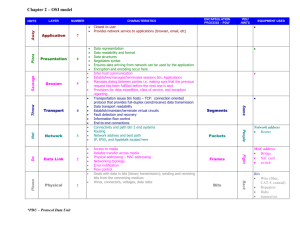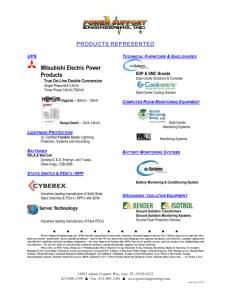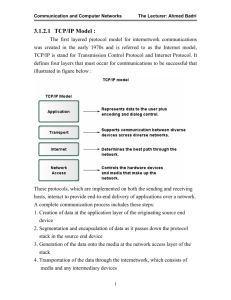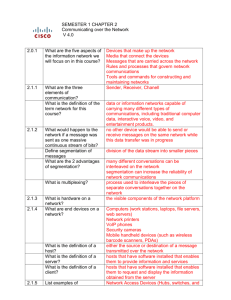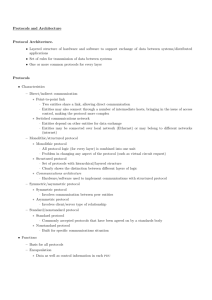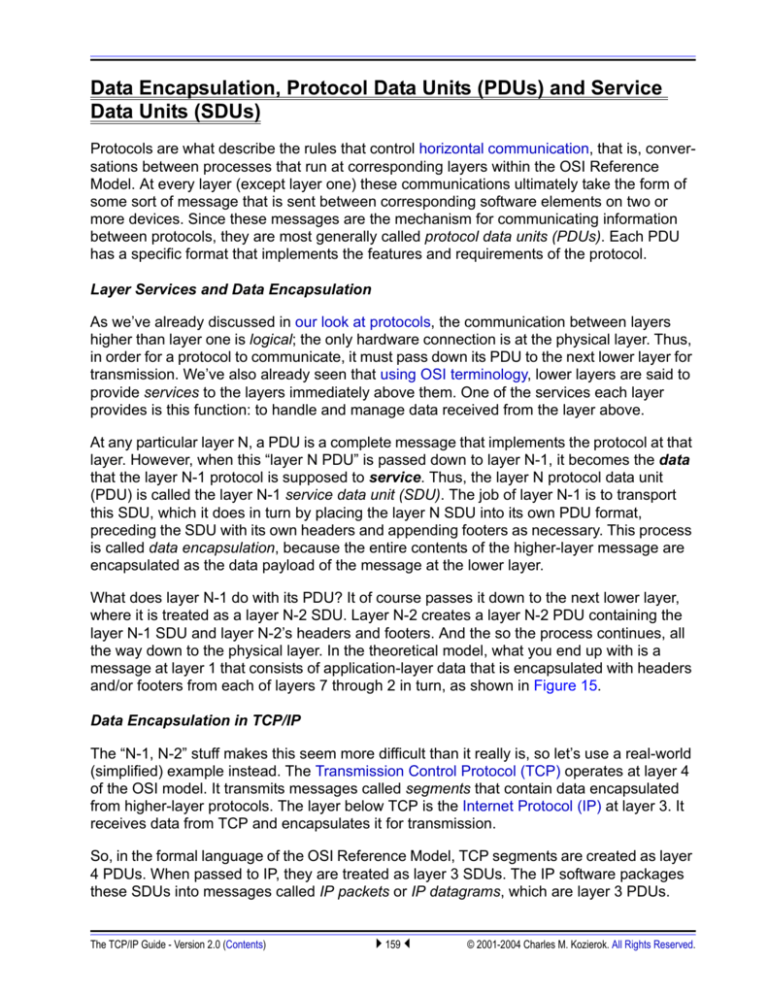
Data Encapsulation, Protocol Data Units (PDUs) and Service
Data Units (SDUs)
Protocols are what describe the rules that control horizontal communication, that is, conversations between processes that run at corresponding layers within the OSI Reference
Model. At every layer (except layer one) these communications ultimately take the form of
some sort of message that is sent between corresponding software elements on two or
more devices. Since these messages are the mechanism for communicating information
between protocols, they are most generally called protocol data units (PDUs). Each PDU
has a specific format that implements the features and requirements of the protocol.
Layer Services and Data Encapsulation
As we’ve already discussed in our look at protocols, the communication between layers
higher than layer one is logical; the only hardware connection is at the physical layer. Thus,
in order for a protocol to communicate, it must pass down its PDU to the next lower layer for
transmission. We’ve also already seen that using OSI terminology, lower layers are said to
provide services to the layers immediately above them. One of the services each layer
provides is this function: to handle and manage data received from the layer above.
At any particular layer N, a PDU is a complete message that implements the protocol at that
layer. However, when this “layer N PDU” is passed down to layer N-1, it becomes the data
that the layer N-1 protocol is supposed to service. Thus, the layer N protocol data unit
(PDU) is called the layer N-1 service data unit (SDU). The job of layer N-1 is to transport
this SDU, which it does in turn by placing the layer N SDU into its own PDU format,
preceding the SDU with its own headers and appending footers as necessary. This process
is called data encapsulation, because the entire contents of the higher-layer message are
encapsulated as the data payload of the message at the lower layer.
What does layer N-1 do with its PDU? It of course passes it down to the next lower layer,
where it is treated as a layer N-2 SDU. Layer N-2 creates a layer N-2 PDU containing the
layer N-1 SDU and layer N-2’s headers and footers. And the so the process continues, all
the way down to the physical layer. In the theoretical model, what you end up with is a
message at layer 1 that consists of application-layer data that is encapsulated with headers
and/or footers from each of layers 7 through 2 in turn, as shown in Figure 15.
Data Encapsulation in TCP/IP
The “N-1, N-2” stuff makes this seem more difficult than it really is, so let’s use a real-world
(simplified) example instead. The Transmission Control Protocol (TCP) operates at layer 4
of the OSI model. It transmits messages called segments that contain data encapsulated
from higher-layer protocols. The layer below TCP is the Internet Protocol (IP) at layer 3. It
receives data from TCP and encapsulates it for transmission.
So, in the formal language of the OSI Reference Model, TCP segments are created as layer
4 PDUs. When passed to IP, they are treated as layer 3 SDUs. The IP software packages
these SDUs into messages called IP packets or IP datagrams, which are layer 3 PDUs.
The TCP/IP Guide - Version 2.0 (Contents)
` 159 _
© 2001-2004 Charles M. Kozierok. All Rights Reserved.
7
L7H
Data
7
6
L6H L7H
Data
6
5
L5H L6H L7H
Data
5
4
L4H L5H L6H L7H
Data
4
3
L3H L4H L5H L6H L7H
Data
3
2
L2H L3H L4H L5H L6H L7H
Data
1
L2F
1 0 0 1 0 1 1 0 1 1 0 0 1 0 1 1
2
1
Figure 15: OSI Reference Model Data Encapsulation
Each protocol creates a protocol data unit (PDU) for transmission that includes headers required by that
protocol and data to be transmitted. This data becomes the service data unit (SDU) of the next layer below it.
This diagram shows a layer 7 PDU consisting of a layer 7 header (“L7H”) and application data. When this is
passed to layer 6, it becomes a layer 6 SDU. The layer 6 protocol prepends to it a layer 6 header (“L6H”) to
create a layer 6 PDU, which is passed to layer 5. The encapsulation process continues all the way down to
layer 2, which creates a layer 2 PDU—in this case shown with both a header and a footer—that is converted
to bits and sent at layer 1.
These are in turn passed down to a layer 2 protocol, say Ethernet, which treats IP
datagrams as layer 2 SDUs, and packages them into layer 2 PDUs (Ethernet frames) which
are sent on layer 1. (Actually, in some technologies further encapsulation even occurs at
layer one prior to transmission.)
On the receiving device, the process of encapsulation is reversed. The Ethernet software
inspects the layer 2 PDU (Ethernet frame) and removes from it the layer 2 SDU (IP
datagram) which it passes up to IP as a layer 3 PDU. The IP layer removes the layer 3 SDU
(TCP segment) and passes it to TCP as a layer 4 PDU. TCP in turn continues the process,
going back up the protocol layer stack. The complete process is illustrated in Figure 16.
The TCP/IP Guide - Version 2.0 (Contents)
` 160 _
© 2001-2004 Charles M. Kozierok. All Rights Reserved.
Layer 4 PDU (TCP Segment)
Layer
4 (TCP)
Header
4
Upper Layer SDU
(Data)
4
Layer 3 PDU (IP Datagram)
Layer 3 SDU
Layer 3
(IP)
Header
3
Layer
4 (TCP)
Header
Upper Layer SDU
(Data)
3
Layer 2 PDU (Ethernet Frame)
Layer 2 SDU
Layer 3 SDU
2
1
Layer2
(Ethernet)
Header
Layer 3
(IP)
Header
Layer
4 (TCP)
Header
Upper Layer SDU
(Data)
Layer 2
(Ethernet)
Footer
1 0 0 1 0 1 1 0 1 1 0 0 1 0 1 1
2
1
Figure 16: OSI Reference Model PDU and SDU Encapsulation
This example shows in more detail how OSI PDUs and SDUs are created and encapsulated. A TCP segment
(layer 4 PDU) becomes a layer 3 SDU, which is encapsulated into a layer 3 PDU through the addition of an IP
header. This becomes the payload of an Ethernet frame, which is a layer 2 PDU containing an Ethernet
header, layer 2 SDU (the IP datagram) and Ethernet footer. The receiving device extracts the IP datagram
from the Ethernet header and passes it to layer 3; the IP software extracts the TCP segment and passes it up
to the TCP software.
This whole matter of passing data up and down the protocol stack, encapsulation and so on
may seem needlessly complex. It also may appear to be rather inefficient; why send a
message with so many headers and footer? However, the notion of data encapsulation is
critical to creating modular, flexible networks.
The TCP/IP Guide - Version 2.0 (Contents)
` 161 _
© 2001-2004 Charles M. Kozierok. All Rights Reserved.
Use of PDU and SDU Terminology
The term “protocol data unit” is rather formal. You will see it used in standards and
sometimes in discussions, but more often, the “plain” message terms, such as “frame” and
“datagram”, are encountered, as discussed in the networking fundamentals topic on
messages. Similarly, data encapsulated by these messages is not normally called a
“service data unit” but rather simply the message body or payload, as discussed in the topic
on message formatting. There are cases, however, where knowing the difference between
an SDU and a PDU is important to understanding the technology. One example is the IEEE
802.11 physical layer; the 802.11 standards talk about SDUs and PDUs constantly.
Related Information: See the OSI Reference Model analogy if you want to see
an example that compares networking encapsulation to a type done in a realworld, non-networking context.
Key Concept: The message used to communicate information for a particular
protocol is called its protocol data unit (PDU) in OSI model terminology. That PDU is
passed down to the next lower layer for transmission; since that layer is providing the
service of handling that PDU, it is called the lower layer’s service data unit (SDU). The SDU
is encapsulated into that layer’s own PDU and in turn sent to the next lower layer in the
stack, proceeding until the physical layer is reached. The process is reversed on the
recipient device. In summary: a layer N PDU is a layer N-1 SDU, which is encapsulated into
a layer N-1 PDU.
The TCP/IP Guide - Version 2.0 (Contents)
` 162 _
© 2001-2004 Charles M. Kozierok. All Rights Reserved.

